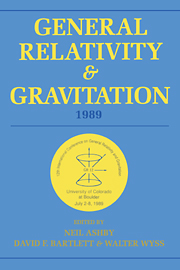 General Relativity and Gravitation, 1989
General Relativity and Gravitation, 1989 Book contents
- Frontmatter
- Contents
- Preface
- Conference committees
- Part A Classical relativity and gravitation theory
- WORKSHOPS
- Part B Relativistic astrophysics, early universe, and classical cosmology
- WORKSHOPS
- Part C Experimental gravitation and gravitational wave detection
- WORKSHOPS
- Part D Quantum gravity, superstrings, quantum cosmology
- WORKSHOPS
- Part E Overviews-past, present, and future
Preface
Published online by Cambridge University Press: 05 March 2012
- Frontmatter
- Contents
- Preface
- Conference committees
- Part A Classical relativity and gravitation theory
- WORKSHOPS
- Part B Relativistic astrophysics, early universe, and classical cosmology
- WORKSHOPS
- Part C Experimental gravitation and gravitational wave detection
- WORKSHOPS
- Part D Quantum gravity, superstrings, quantum cosmology
- WORKSHOPS
- Part E Overviews-past, present, and future
Summary
We note with sadness that GR-12 was the last important conference for two of the significant figures in physics in the last half of the twentieth century: William M. Fairbank and Eduardo Amaldi. Ironically, they were raised in traditions far removed from general relativity but both had made important experimental contributions to the field during the past twenty years. Fairbank, with Schiff, Cannon, and Everitt, started the investigation that we now call the Stanford Relativity Gyroscope experiment and helped bring it to the point that it will be put into orbit as NASA's Gravity Probe B. He then, with Hamilton, started the cryogenic gravity wave detection project at Stanford to further advance the pioneering experiments of Weber. Amaldi joined with Pizzella to build tuned gravity wave detectors in Italy. When the Italian bureaucracy became too difficult he helped move the experimental laboratory to CERN where it has become the world's strongest program.
In the evening of the next to last day of GR-12 both Fairbank and Amaldi attended a small informal meeting of experimentalists representing all of the major tuned bar groups. The focus of the meeting was to establish times when all of the experiments would be operated in coincidence and to establish protocols for exchanging the data that would be generated by these coincidence experiments. They both expressed great confidence that such a coordinated effort would lead us to the discovery of gravitational waves and the development of gravitational wave astronomy.
- Type
- Chapter
- Information
- General Relativity and Gravitation, 1989Proceedings of the 12th International Conference on General Relativity and Gravitation, pp. xv - xviPublisher: Cambridge University PressPrint publication year: 1990
